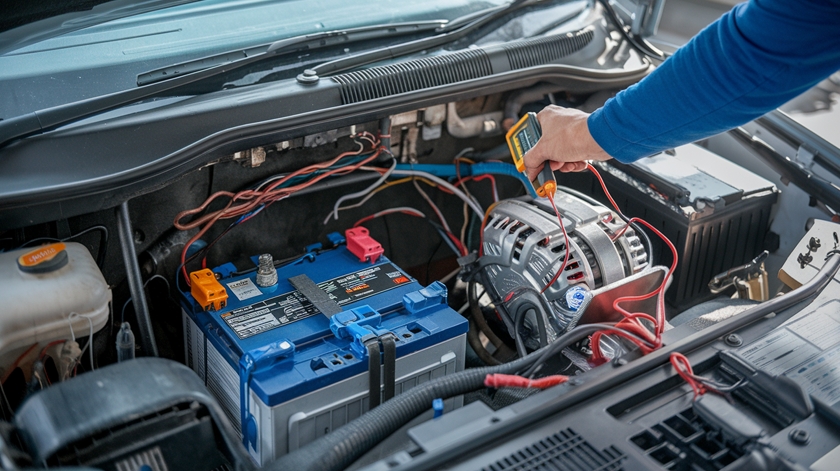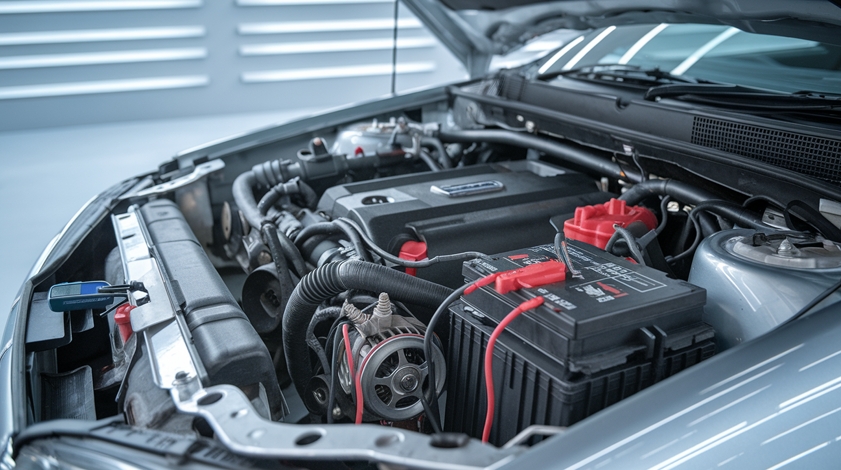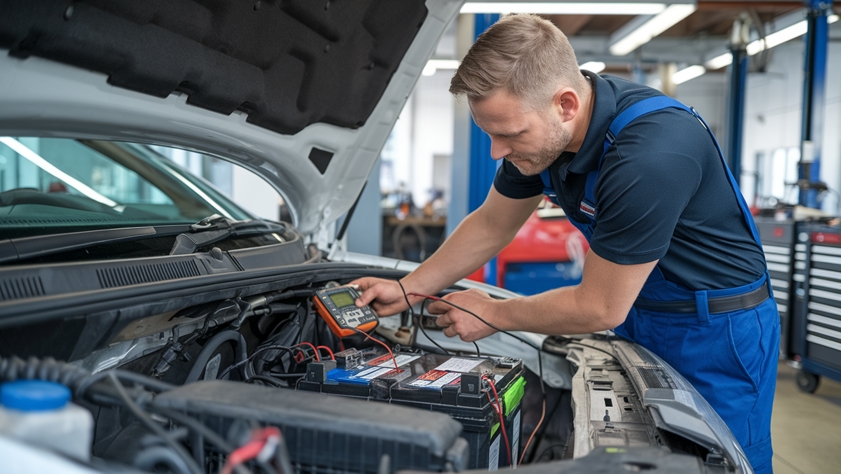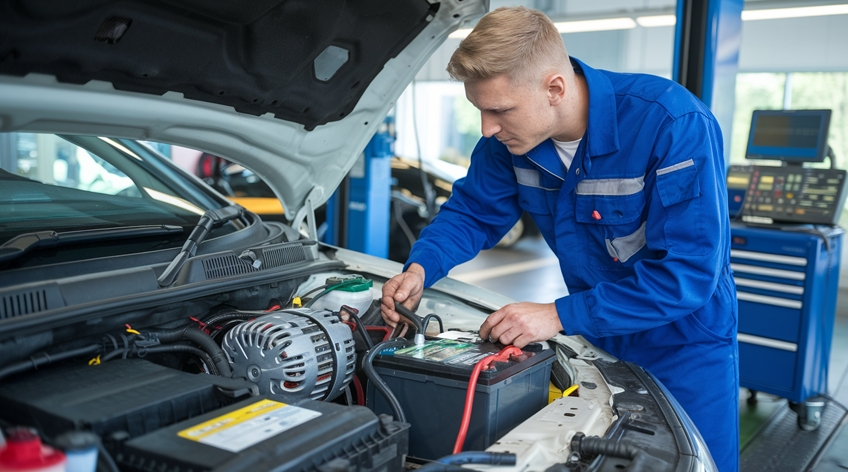
Have you ever turned the key in your car’s ignition, only to be met with silence? Or perhaps you’ve experienced the frustration of flickering headlights or a malfunctioning radio? These issues all stem from one crucial component of your vehicle: the car electrical system. 🚗⚡
While often overlooked, this intricate network of wires, sensors, and components is the lifeblood of your modern automobile. It powers everything from the engine starter to your favorite playlist, ensuring a smooth and comfortable ride. But how much do you really know about what’s happening under the hood?
In this comprehensive guide, we’ll demystify the car electrical system, exploring its core components and functions. From power generation to comfort features, we’ll cover it all. Whether you’re a curious car owner or an aspiring mechanic, buckle up as we take you on an electrifying journey through the heart of your vehicle’s electrical system! 🔧💡
Visit website: Autobiography Zone
Understanding the Basics of Car Electrical Systems

Key components and their functions
The car electrical system comprises several crucial components that work together to power various functions of your vehicle. Let’s explore these key components and their roles:
- Battery: The heart of the electrical system
- Alternator: The power generator
- Starter motor: Initiates engine operation
- Fuse box: Protects electrical circuits
- Wiring harness: Distributes electricity throughout the vehicle
| Component | Primary Function |
|---|---|
| Battery | Stores and provides initial power |
| Alternator | Generates electricity while the engine runs |
| Starter motor | Cranks the engine to start |
| Fuse box | Protects circuits from overload |
| Wiring harness | Distributes electricity to components |
How electricity flows in a vehicle
The flow of electricity in a car is a continuous cycle that begins and ends with the battery. Here’s a simplified overview of the process:
- Battery provides initial power
- Starter motor uses this power to crank the engine
- Once the engine is running, the alternator generates electricity
- The alternator charges the battery and powers other electrical components
- Excess electricity is stored in the battery for future use
This cycle ensures that your car has a constant supply of electrical power, even when the engine is not running.
The role of the battery
The car battery plays a crucial role in the electrical system, serving multiple functions:
- Starting the engine: Provides the initial burst of power to the starter motor
- Voltage stabilization: Maintains a steady voltage for electrical components
- Power reserve: Supplies electricity when the alternator isn’t producing enough
- Memory preservation: Keeps electronic settings and memory alive when the car is off
Car batteries typically come in two types:
- Lead-acid batteries (traditional)
- Lithium-ion batteries (newer technology)
| Battery Type | Pros | Cons |
|---|---|---|
| Lead-acid | Affordable, widely available | Heavier, shorter lifespan |
| Lithium-ion | Lighter, longer lifespan | More expensive, less common |
Understanding these basics of car electrical systems is crucial for proper maintenance and troubleshooting. As we delve deeper into the power generation and storage mechanisms in the next section, you’ll gain a more comprehensive understanding of how these components work together to keep your vehicle running smoothly.
Power Generation and Storage

A. Alternator: The heart of power generation
The alternator is the unsung hero of your car’s electrical system, tirelessly generating the power needed to keep your vehicle running smoothly. This crucial component converts mechanical energy from the engine into electrical energy, ensuring a constant supply of power to your car’s various electrical components.
How the alternator works:
- Belt-driven system
- Rotor and stator interaction
- AC to DC conversion
- Voltage regulation
The alternator’s operation begins with a belt-driven pulley system connected to the engine. As the engine runs, it spins the alternator’s rotor, which is surrounded by a stationary stator. This interaction creates alternating current (AC) through electromagnetic induction. The AC is then converted to direct current (DC) using a rectifier, making it suitable for charging the battery and powering your car’s electrical systems.
| Alternator Component | Function |
|---|---|
| Rotor | Spins to create magnetic field |
| Stator | Generates AC electricity |
| Rectifier | Converts AC to DC |
| Voltage regulator | Maintains consistent output |
B. Battery types and maintenance
While the alternator generates power, the battery stores it for use when the engine isn’t running. There are two primary types of car batteries:
- Lead-acid batteries (most common)
- Absorbed Glass Mat (AGM) batteries
Lead-acid batteries are the traditional choice, offering reliability at a lower cost. AGM batteries, on the other hand, provide better performance, longer life, and are more resistant to vibration, making them ideal for high-performance vehicles or those with advanced electrical systems.
Battery maintenance tips:
- Keep terminals clean and free of corrosion
- Ensure proper water levels in non-sealed batteries
- Avoid deep discharges
- Regularly check for signs of wear or damage
Proper maintenance can significantly extend your battery’s life and prevent unexpected failures. Remember to have your battery tested regularly, especially before extreme weather conditions.
C. Voltage regulators explained
Voltage regulators play a crucial role in maintaining the stability of your car’s electrical system. They ensure that the alternator produces a consistent voltage output, typically around 14.2 volts for most vehicles. This consistency is vital for protecting sensitive electronic components and ensuring optimal battery charging.
Functions of a voltage regulator:
- Monitors alternator output
- Adjusts field current
- Prevents overcharging
- Maintains system stability
Modern voltage regulators are often integrated into the alternator itself, forming a single unit known as a “smart charging system.” These advanced systems can communicate with the car’s onboard computer to optimize charging based on various factors such as engine load, battery condition, and electrical demand.
| Voltage Regulator Type | Characteristics |
|---|---|
| Mechanical | Older technology, less precise |
| Electronic | More accurate, longer-lasting |
| Smart charging system | Integrated with vehicle computer |
Understanding these components and their interactions is crucial for maintaining your car’s electrical system. Regular checks and maintenance of your alternator, battery, and voltage regulator can prevent many common electrical issues and ensure your vehicle remains reliable for years to come.
Starting and Ignition Systems

Starter motor operation
The starter motor is a crucial component in your car’s electrical system, responsible for initiating the engine’s rotation. When you turn the key or press the start button, the starter motor engages, converting electrical energy from the battery into mechanical energy to crank the engine.
Here’s a breakdown of the starter motor operation:
- Engagement: The starter solenoid receives an electrical signal, pushing out a drive gear.
- Meshing: The drive gear meshes with the engine’s flywheel.
- Cranking: The starter motor rotates, turning the flywheel and engine crankshaft.
- Disengagement: Once the engine starts, the starter motor disengages automatically.
| Component | Function |
|---|---|
| Solenoid | Engages the starter drive gear |
| Drive gear | Meshes with the flywheel |
| Armature | Rotates to provide mechanical energy |
| Commutator | Directs current flow in the armature |
Ignition coils and spark plugs
Ignition coils and spark plugs work together to create the spark necessary for combustion in gasoline engines. The ignition coil acts as a transformer, converting the battery’s low voltage into the high voltage required for spark generation.
Key points about ignition coils and spark plugs:
- Ignition coils step up voltage from 12V to around 30,000V or more
- Modern cars often use individual coil-on-plug systems for each cylinder
- Spark plugs create a gap where the high-voltage spark jumps, igniting the air-fuel mixture
- Proper spark plug gap is crucial for optimal engine performance
Electronic ignition advantages
Electronic ignition systems have largely replaced older mechanical systems, offering several advantages:
- Improved reliability: Fewer moving parts mean less wear and tear
- Better fuel efficiency: More precise timing and stronger sparks
- Reduced maintenance: No need for regular adjustments
- Enhanced performance: Consistent spark energy across all RPM ranges
- Easier starting: More efficient spark generation in cold conditions
| Feature | Mechanical Ignition | Electronic Ignition |
|---|---|---|
| Timing accuracy | Variable | Precise |
| Maintenance | Regular adjustments needed | Minimal maintenance |
| Spark strength | Decreases over time | Consistent |
| Cold-start performance | Less efficient | More efficient |
Electronic ignition systems use sensors to monitor engine conditions and adjust spark timing accordingly. This real-time adaptation ensures optimal performance across various driving conditions and helps reduce emissions.
Now that we’ve covered the starting and ignition systems, let’s explore how your car’s electrical system handles lighting and signaling, which are crucial for safe driving and communication with other road users.
Visit website: Autobiography Zone
Lighting and Signaling

Headlights, taillights, and brake lights
The lighting system in your car plays a crucial role in ensuring safe driving conditions, especially during low visibility situations. Headlights, taillights, and brake lights are essential components of this system, each serving a specific purpose.
Headlights illuminate the road ahead, allowing you to see and be seen by other drivers. Modern vehicles often feature different types of headlights:
- Halogen: Traditional and cost-effective
- LED: Energy-efficient and long-lasting
- Xenon/HID: Bright and intense light output
Taillights and brake lights, on the other hand, make your vehicle visible from behind and signal your intentions to other drivers.
Here’s a comparison of these lighting components:
| Light Type | Primary Function | Color | Activation |
|---|---|---|---|
| Headlights | Illuminate road ahead | White | Manual or automatic |
| Taillights | Visibility from behind | Red | Activated with headlights |
| Brake lights | Signal stopping/slowing | Red (brighter) | Activated when brakes applied |
Turn signals and hazard lights
Turn signals and hazard lights are vital for communicating your intentions to other drivers, pedestrians, and cyclists. These lights play a crucial role in preventing accidents and ensuring smooth traffic flow.
Turn signals:
- Indicate your intention to turn or change lanes
- Usually amber/orange in color
- Activated by the turn signal lever
Hazard lights:
- Warn other drivers of potential danger or your vehicle’s stationary position
- Involve all turn signal lights flashing simultaneously
- Activated by a dedicated button, often marked with a triangle symbol
It’s important to use these signals correctly and consistently. Here are some best practices:
- Always use turn signals when changing lanes or turning
- Activate turn signals well in advance of your maneuver
- Use hazard lights when your vehicle is stopped in a potentially dangerous location
- Check your turn signals and hazard lights regularly to ensure they’re functioning properly
Interior lighting systems
Interior lighting in your car serves both functional and aesthetic purposes. These lights enhance visibility inside the vehicle and contribute to a comfortable driving experience.
Common interior lighting components include:
- Dome lights: Provide general illumination for the entire cabin
- Map lights: Focused lighting for reading maps or documents
- Ambient lighting: Soft, decorative lighting that enhances the interior’s appearance
- Instrument panel lights: Illuminate the dashboard and controls
- Glove box light: Activates when the glove compartment is opened
Many modern vehicles offer customizable interior lighting options, allowing drivers to adjust brightness levels and even choose different colors to suit their preferences.
When maintaining your car’s lighting system, remember to:
- Regularly check all lights for proper functioning
- Replace burnt-out bulbs promptly
- Clean light covers to ensure maximum brightness
- Consider upgrading to LED bulbs for improved efficiency and longevity
With a well-maintained lighting and signaling system, you’ll enhance your safety on the road and enjoy a more comfortable driving experience. Next, we’ll explore the comfort and convenience features that modern car electrical systems offer, further enhancing your driving pleasure.
Comfort and Convenience Features

Power windows and door locks
Power windows and door locks have become standard features in modern vehicles, enhancing both comfort and security. These electrical systems work through a network of switches, motors, and control modules to provide effortless operation.
How power windows work:
- User input: Driver or passenger presses the window switch
- Signal transmission: Switch sends an electrical signal to the control module
- Motor activation: Control module activates the window motor
- Mechanical operation: Motor turns gears to raise or lower the window
Power door locks function similarly, using actuators instead of motors to engage or disengage the locking mechanism.
Climate control systems
Modern climate control systems have evolved from simple manual air conditioning to sophisticated automatic temperature regulation. These systems integrate various components to maintain optimal cabin comfort.
Key components of climate control systems:
- Compressor
- Condenser
- Evaporator
- Blower motor
- Temperature sensors
- Control module
| Feature | Basic A/C | Automatic Climate Control |
|---|---|---|
| Temperature control | Manual adjustment | Automatic regulation |
| Zone control | Single zone | Multi-zone options |
| Air quality | Basic filtration | Advanced air purification |
| Energy efficiency | Standard | Improved with smart algorithms |
Audio and infotainment systems
Car audio systems have transformed into comprehensive infotainment centers, offering a wide range of features beyond just playing music. These systems now integrate:
- Touchscreen displays
- Smartphone connectivity (Apple CarPlay, Android Auto)
- GPS navigation
- Voice control
- Bluetooth functionality
- Multiple speaker configurations
Modern infotainment systems often serve as the central hub for controlling various vehicle functions, including climate control and vehicle settings.
Advanced driver assistance features
The integration of advanced driver assistance systems (ADAS) has significantly enhanced vehicle safety and convenience. These features rely heavily on the car’s electrical system, utilizing sensors, cameras, and control modules to assist the driver.
Common ADAS features include:
- Adaptive cruise control
- Lane departure warning and lane-keeping assist
- Automatic emergency braking
- Blind-spot monitoring
- Parking assistance systems
These systems work together to improve safety and reduce driver fatigue. For example, adaptive cruise control uses radar sensors to maintain a safe distance from the vehicle ahead, automatically adjusting speed as needed.
As vehicle technology continues to advance, we can expect to see even more sophisticated comfort and convenience features integrated into car electrical systems. These innovations not only enhance the driving experience but also pave the way for the future of autonomous vehicles.
Diagnosing Electrical Issues

Common symptoms of electrical problems
When it comes to diagnosing electrical issues in your car, recognizing the common symptoms is crucial. Here are some telltale signs that may indicate electrical problems:
- Dim or flickering lights
- Difficulty starting the engine
- Battery issues (weak or dead)
- Unusual dashboard warning lights
- Malfunctioning accessories (power windows, radio, etc.)
- Burning smell or visible smoke
- Fuses that keep blowing
It’s important to address these symptoms promptly to prevent further damage to your vehicle’s electrical system.
Using multimeters and diagnostic tools
Multimeters and diagnostic tools are essential for accurately identifying and troubleshooting electrical issues in your car. Here’s a comparison of some common diagnostic tools:
| Tool | Function | Skill Level Required |
|---|---|---|
| Multimeter | Measures voltage, current, and resistance | Beginner to Intermediate |
| OBD-II Scanner | Reads and interprets error codes | Beginner |
| Oscilloscope | Visualizes electrical signals | Advanced |
| Circuit Tester | Checks for power in circuits | Beginner |
| Battery Load Tester | Tests battery capacity and alternator output | Intermediate |
When using a multimeter, follow these steps:
- Set the multimeter to the appropriate function (voltage, current, or resistance)
- Connect the probes to the correct points in the circuit
- Take the reading and compare it to the manufacturer’s specifications
- Interpret the results to identify potential issues
Reading and interpreting error codes
Modern vehicles are equipped with onboard diagnostic systems that generate error codes when issues arise. These codes provide valuable information about the nature and location of electrical problems. Here’s how to read and interpret them:
- Connect an OBD-II scanner to your car’s diagnostic port
- Turn on the ignition (but don’t start the engine)
- Follow the scanner’s instructions to retrieve the codes
- Look up the codes in your vehicle’s manual or online databases
Error codes typically follow this format:
- Letter prefix (P for powertrain, B for body, C for chassis, U for network)
- First digit (0 for generic, 1 for manufacturer-specific)
- Remaining digits (indicate the specific system and issue)
For example, a P0456 code indicates a small leak in the evaporative emission control system.
Remember that error codes are starting points for diagnosis, not definitive solutions. They often require further investigation and testing to pinpoint the exact cause of the problem.
By familiarizing yourself with these diagnostic techniques, you’ll be better equipped to identify and address electrical issues in your vehicle. However, for complex problems or if you’re unsure about your diagnosis, it’s always best to consult a professional mechanic. In the next section, we’ll explore essential maintenance practices to keep your car’s electrical system in top condition.
Maintaining Your Car’s Electrical System

Regular battery checks and replacement
Regular battery maintenance is crucial for keeping your car’s electrical system in top shape. Here’s what you need to know:
- Visual inspection: Check for signs of corrosion, cracks, or bulges.
- Voltage testing: Use a multimeter to ensure proper voltage (12.6V when fully charged).
- Load testing: Assess the battery’s ability to hold a charge under load.
- Cleaning: Remove corrosion from terminals using a wire brush and baking soda solution.
Typical battery lifespan:
| Climate | Average Lifespan |
|---|---|
| Hot | 3-4 years |
| Moderate | 4-5 years |
| Cold | 5-6 years |
Replace your battery when it shows signs of weakness or reaches the end of its expected lifespan.
Keeping connections clean and tight
Loose or corroded connections can cause numerous electrical issues. Follow these steps to maintain proper connections:
- Identify key connection points (battery terminals, alternator, starter, etc.)
- Clean connections using a wire brush and electrical contact cleaner
- Tighten all connections to manufacturer specifications
- Apply dielectric grease to prevent future corrosion
Fuse replacement and circuit protection
Fuses are essential for protecting your car’s electrical components. Here’s how to maintain them:
- Locate your car’s fuse box (usually under the dashboard or in the engine compartment)
- Familiarize yourself with the fuse diagram in your owner’s manual
- Check fuses regularly for signs of failure (discoloration or broken metal strip)
- Replace blown fuses with ones of the same amperage rating
- If a fuse blows repeatedly, seek professional diagnosis
Types of automotive fuses:
- Blade fuses (most common)
- Glass tube fuses
- Cartridge fuses
- High-current fuses
When to seek professional help
While many electrical maintenance tasks can be done at home, some situations require expert attention:
- Complex wiring issues
- Alternator or starter motor problems
- Persistent electrical failures
- Dashboard warning lights that won’t clear
- Installation of aftermarket electrical components
When in doubt, consult a certified automotive electrician to avoid potentially costly mistakes or safety hazards.
Now that we’ve covered the essentials of maintaining your car’s electrical system, let’s address some frequently asked questions to further enhance your understanding of this critical aspect of vehicle care.
Visit website: Autobiography Zone


